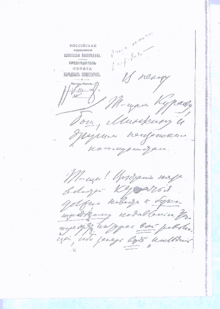Russian/Cursive
| Russian language · Русский язык | ||
| Lessons | Introduction · Alphabet · Lesson 1 · Lesson 2 · Lesson 3 · Lesson 4 · Lesson 5 | (view) (edit) |
|---|---|---|
| Reference | Numbers · Cases (Nom. · Gen. · Dat. · Acc. · Inst. · Prep.) · Adjectives · Prepositions · Verbs (Aspect · Past · Future) · Pronouns (Personal · Possessive · Interrogative) · Cursive | |
| Appendices | Appendix · Alphabet · Internet · Cheat Sheet | |
| A reader requests expansion of this page to include more material. You can help by adding new material (learn how) or ask for assistance in the reading room. |
| This page may need to be updated to reflect current knowledge. You can help update it, discuss progress, or request assistance. |
Russian cursive (русские рукописные буквы, russkiye rukopisnyye bukvy) is a basic part of studying the Russian language. Because most written Russian is cursive, learning cursive is fundamental to understanding other Russians.

On the whole, writing cursive is very similar to those familiar with English cursive, but this material will start from the most elementary level of Russian cursive.
The samples of writing of russian cursive are shown on the following picture. The letters "ъ", "ь" and "ы" can't be capitalized, because Russian words never begin with them.
Some people write "т" as it appears on typographic fonts (not like latin "m"). Others have a different way of writing capital "П" and "Т" (Lenin was one of them - look at the "Т" in "Т-щи"). Some people (if they write "т" like in this example) put a little lines over "т" and under "ш"? to make this distinction more obvious.
Basic information
edit- Cursive is a style of writing in which most if not all letters in one word are connected by ancillary serifs. With this method, a single word can usually be written in one stroke.
- Russian culture highly regards cursive, similar to the way Chinese culture exalts good calligraphy.